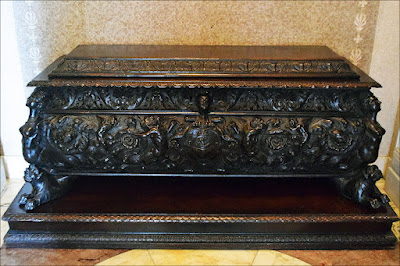 |
| Portrait of a Man, Possibly a Self-Portrait, ca. 1660, black, white, and red chalk on brown paper, Peter Lely (1618-1680) |
Thankfully, I have zero interest in the Olympics. Instead of wasting my time watching the Eldest Daughter of the Church degrade itself before the whole world with its blatantly blasphemous and perverse opening ceremony, I spent my day reveling in traditional European high art at the Morgan Library and Museum in New York City.
[See Part 1]
Highlights from ‘Far and Away: Drawings from the Clement C. Moore Collection’ (June 28 through September 22, 2024)
 |
| Wooded Landscape with Shepherds, Sheep and Cottage, ca. 1760-63, watercolor and opaque watercolor, over graphite, on tan paper, Thomas Gainsborough (1727-1788) |
 |
| A Watermill, ca. 1833-36, pen and brown ink and watercolor, with white opaque watercolor and scratching out, over graphite, John Constable (1776-1837) |
 |
| Study of a Mackerel, ca. 1845, watercolor, over graphite, on hot-pressed paper, Joseph Mallord William Turner (1775-1851) |
 |
| View from Neptune's Grotto in Tivoli, ca. 1660-70, brush and gray and brown ink and wash, over black chalk, attributed to Johannes Jansz Collaert (ca. 1621/22-1679) |
 |
| A Wooded Landscape with Roma Gathered around a Fire, ca. 1778-80, pen and brown ink and wash, with opaque white watercolor, over black chalk, on brown paper, Thomas Gainsborough (1727-1788) |
 |
| The Entry of Christ in Jerusalem, ca. 1610, pen and brown ink, with gray, brown, and blue wash and white opaque watercolor, over traces of black chalk, David Vinckboons (1576-ca. 1632) |
 |
| Figures in a Wooded Landscape with a City in the Distance, ca. 1620-30, brush and blue ink, over black chalk, squared in black chalk, Isaak Major (ca. 1576-after 1642) |
 |
| Callisto's Pregnancy Revealed to Diana, ca. 1600, black and white chalk, with traces of blue and pink chalk, Hendrick Goltzius (1558-1617) |
 |
| The Birth of St. John the Baptist, ca. 1660-65, black, red, and white chalk, with pen and brown ink, and red, gray, and blue wash, on three pieces of joined paper, Jacob Jordaens (1593-1678) |
 |
| St. Lambert, ca. 1630-33, pen and brown ink and wash, and black chalk, Peter Paul Rubens (1577-1640) |
 |
| The Return of Cincinnatus to Rome, ca. 1590-1600, pen and brown ink and wash, and black chalk, with white opaque watercolor, Jan van der Straet (known as Johannes Stradanus) (1523-1605) |
 |
| The Mocking of the Spaniard, 1642, black chalk and gray wash on parchment, Pieter Jansz Quast (1605/6-1647) |
 |
| The East Room |
 |
| St. John the Baptist, ca. 1495-1500, marble, Giovanni Francesco Rustici (1474-1554) |
 |
| Bronze bust of Alfonso II d’Avalos (1502-1546), Marquis of Pescara and Vasto, by Annibale Fontana (1540-1587) |
 |
| Portrait of a Man with a Pink Flower, ca. 1480-85, oil on panel, Hans Memling (ca. 1440-1494) |
 |
| Kneeling male donor with his patron, St. William of Maleval, ca. 1467-70, oil on panel, Hans Memling (ca. 1440-1494) |
 |
| A peek inside the vault in J.P. Morgan's Study |
 |
| Carved Cassone with Base, wood (likely walnut), 64 x 23 x 25 inches, possibly acquired in 1906 |
 |
| Detail of elaborately carved sphinx and lion |
 |
| Detail of elaborately carved lion |
 |
| Detail of elaborately carved lion |
 |
| Perséphone, Paris: Édition Russe de Musique; Berlin: Russischer Musikverlag, [ca. 1934]. Cover illustration by Théodore Stravinsky (1907-1989) |
 |
| Bestiaire d'amour (Bestiary of love), in Old French, Northern Italy, ca. 1290, Richard de Fournival |
 |
| Les abus du monde (The Abuses of the World), in French, France, Rouen, ca. 1510, Pierre Gringore |
 |
| Liber de sapiente (Book on Wisdom), Charles de Bovelles, Paris: printed by Henri Estienne for Jean Petit, 1510 |


